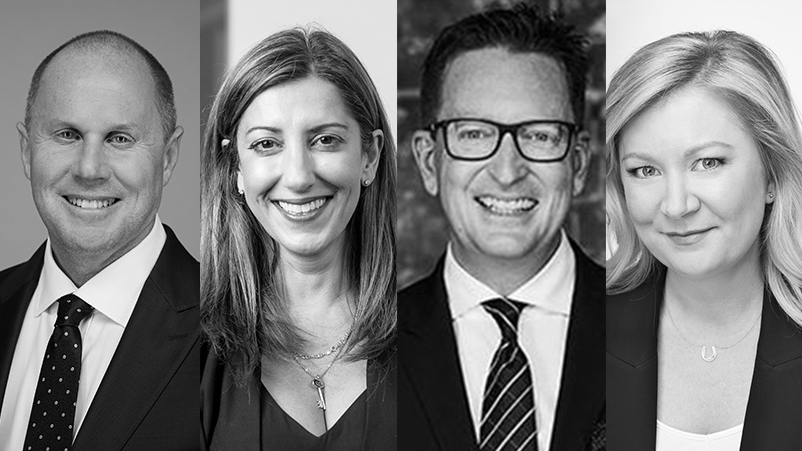The Sydney Morning Herald, Nine News editors talk COVID ad blacklists and a swing to non-COVID content with Carat CEO Sue Squillace, Michael Stephenson

L-R: Darren Wick, Nine's Director of News & Current Affairs; Sue Squillace, CEO, Carat; Michael Stephenson, Chief Sales Officer, Nine; Lisa Davies, Editor, Sydney Morning Herald
Carat's CEO Sue Squillace says her strategy teams "have never been busier" as they work with brands preparing for the start of a post-COVID marketing phase from July - at this stage. Squillace joins The Sydney Morning Herald Editor Lisa Davies, Nine's Director of News & Current Affairs, Darren Wick and Chief Sales Officer Michael Stephenson on early signs of a swing to non-COVID content, a long-term shake-up to faster, lower-cost newsrooms, 20-40% June-quarter ad market declines and why the boom in online shopping is shaking up the media mix to online performance channels - for now.
You need to know this:
- The Sydney Morning Herald editor Lisa Davies reports a "huge uplift" in subscriptions since the bushfires crisis and now COVID-19 - she would not reveal numbers but says "it's extraordinary...I'm talking many hundreds of percentage growth"
- The Herald daily COVID blog is attracting 1.4 million users per day, up from circa 700,000 during the bushfires
- Davies says The Herald is "definitely seeing the need for more non-COVID content". Last week Good Weekend was COVID-free and "extremely well read". The Herald has quarantined several reporters specifically for non-COVID coverage. "We're definitely seeing the need for more non-COVID related coverage...but it's pretty hard to focus on the good when there's so much bad going on," she says.
- For the first time in 188 years, The Herald has been putting print and online editions out remotely. The editorial team have been using multiple Slack channels to manage the process.
- Nine's Director of News and Current Affairs Darren Wick says TV news audience numbers are hitting levels he's not seen for a decade
- Many of the forced changes to how the Nine newsroom produces its coverage will stay post-COVID - faster, cheaper. "It's a quantum leap for us," he says. "I do see opportunities to save money there and possibly do things a lot quicker than what we might have traditionally done". Wick says there's a "real technology switch for us", citing The Today Show's use of Skype for interviews locally, nationally and abroad. Nine can avoid hiring studios and associated talent and shoot on Skype from home. "It's going to be a much more normal way of doing business," he says. "It's the same for news. Rather than gathering and getting a crew to drive halfway across Sydney or Melbourne for an interview, we'll just pick that up as a Skype interview. There are huge savings and it is going to be second nature to people."
- Carat CEO Sue Squillace says her client base - including Woolworths and BWS - want to invest in trusted, traditional media channels because they're "safer to be around" but broadcast TV has taken an advertising hit. Squillace says the rise of online shopping through COVID and the rapid switch by companies to e-commerce strategies has triggered a shift in media mix to online performance channels which typically have much lower ad rates and are aimed primarily as gateways to a transaction
- Squillace says an ad market decline in the June quarter of around 30% is likely. "That's going to be a big shift but we're seeing clients just moving their media around, they are not neccessarily cutting spend. They're shifting between channels, depending on what's happened to their business or where people are consuming media. What we've seen with consumer goods clients is a move away from broadcast in the short-term. They're in digital channels and that's all around their e-commerce businesses - they're seeing double-digit growth in a matter of weeks
- Nine's Chief Sales Officer Michael Stephenson concurred with Squillace on a circa 30% decline in the ad market for the June quarter but countered on the shift out of broadcast to digital channels. "We're a digital business too but for 100 years, share-of-voice has contributed to share-of-market," he says. "I would be very wary if I was a brand marketer or a business leader to move money out of proven media channels like television, radio, publishing, where we're seeing these huge increases in audience, to be too heavily reliant upon digital channels or to focus only on digital channels."
- Squillace says it's a short-term approach but inevitable. "I understand a great broadcast or publishing media brand has never been more important but we have seen significant client shifts into digital to support their e-commerce businesses."
- Stephenson says the early online advertising bans on COVID-related news are settling down as advertisers adjust their tone and messaging. "There will be brands that, probably without knowing it, are not advertising around that content because some of the keywords that they've potentially blacklisted will preclude them from being in and around the content we're creating or that consumers are engaging with in such great numbers
- Squillace agrees about an easing of COVID-related news blacklists. "The first thing our clients did was look at their creative and make sure that it was the right product and right message - that's particularly important around COVID. This isn't something that's going away. Consumers are turning to news and they're turning to it online so for us it's just applying a layer of sensitivity around the message and making sure that message is appropriate for where the ad is appearing.
A more detailed, abridged version of Mi3's podcast with Lisa Davies, Darren Wick, Sue Squillace and Michael Stephenson will be published in Thursday's edition. Until then, listen to the podcast here.

